Related Research Articles
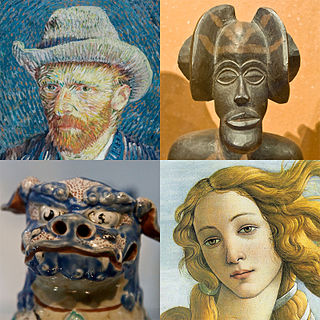
Art is a diverse range of human activities involving the conscious use of creative imagination to express technical proficiency, beauty, emotional power, or conceptual ideas.

Aesthetics, or esthetics, is a branch of philosophy that deals with the nature of beauty and taste, as well as the philosophy of art. It examines subjective and sensori-emotional values, or sometimes called judgments of sentiment and taste.

Dance is a performing art form consisting of sequences of movement, either improvised or purposefully selected. This movement has aesthetic and often symbolic value. Dance can be categorized and described by its choreography, by its repertoire of movements, or by its historical period or place of origin.

Humanities are academic disciplines that study aspects of human society and culture. In the Renaissance, the term contrasted with divinity and referred to what is now called classics, the main area of secular study in universities at the time. Today, the humanities are more frequently defined as any fields of study outside of professional training, mathematics, and the natural and sometimes social sciences.

Postmodern art is a body of art movements that sought to contradict some aspects of modernism or some aspects that emerged or developed in its aftermath. In general, movements such as intermedia, installation art, conceptual art and multimedia, particularly involving video are described as postmodern.
Cultural history combines the approaches of anthropology and history to look at popular cultural traditions and cultural interpretations of historical experience. It examines the records and narrative descriptions of past matter, encompassing the continuum of events pertaining to a culture.
Laban movement analysis (LMA), sometimes Laban/Bartenieff movement analysis, is a method and language for describing, visualizing, interpreting and documenting human movement. It is based on the original work of Rudolf Laban, which was developed and extended by Lisa Ullmann, Irmgard Bartenieff, Warren Lamb and others. LMA draws from multiple fields including anatomy, kinesiology and psychology. It is used by dancers, actors, musicians and athletes; by health professionals such as physical and occupational therapists and psychotherapists; and in anthropology, business consulting and leadership development.

The Black Arts Movement (BAM) was an African American-led art movement, active during the 1960s and 1970s. Through activism and art, BAM created new cultural institutions and conveyed a message of black pride.

Aesthetics of music is a branch of philosophy that deals with the nature of art, beauty and taste in music, and with the creation or appreciation of beauty in music. In the pre-modern tradition, the aesthetics of music or musical aesthetics explored the mathematical and cosmological dimensions of rhythmic and harmonic organization. In the eighteenth century, focus shifted to the experience of hearing music, and thus to questions about its beauty and human enjoyment of music. The origin of this philosophic shift is sometimes attributed to Baumgarten in the 18th century, followed by Kant.

High culture encompasses the cultural objects of aesthetic value, which a society collectively esteem as exemplary art, and the intellectual works of philosophy, history, and literature that a society consider representative of their culture.
This is an alphabetical index of articles about aesthetics.
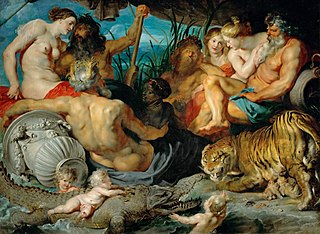
A work of art, artwork, art piece, piece of art or art object is an artistic creation of aesthetic value. Except for "work of art", which may be used of any work regarded as art in its widest sense, including works from literature and music, these terms apply principally to tangible, physical forms of visual art:
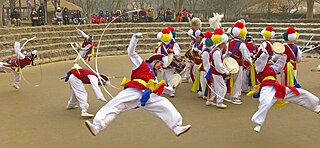
Pungmul is a Korean folk music tradition that includes drumming, dancing, and singing. Most performances are outside, with dozens of players all in constant motion. Pungmul is rooted in the dure farming culture. It was originally played as part of farm work, on rural holidays, at other village community-building events, and to accompany shamanistic rituals, mask dance dramas, and other types of performance. During the late 1960s and 1970s it expanded in meaning and was actively used in political protest during the pro-democracy movement, although today it is most often seen as a performing art.

Dark culture, also called dark alternative scene, includes goth and dark wave culture, electro subculture and parts of the neofolk and post-industrial subcultures. Dark culture's origin lies in followers of dark wave and independent music, but over the decades it has developed to a social network held together by a common concept of aesthetics, self-representation, and individualism. The musical preferences of the dark scene are characterized by a mix of styles ranging from futurism, electropop, early music, (neo-) classical, and folk music to punk rock, rock, techno and ambient music.
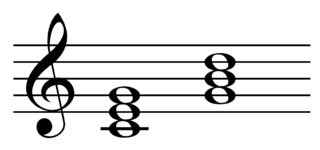
In music, gesture is any movement, either physical (bodily) or mental (imaginary). As such "gesture" includes both categories of movements required to produce sound and categories of perceptual moves associated with those gestures. The concept of musical gestures has received much attention in various musicological disciplines in recent years.

Dance in Indonesia reflects the country's diversity of ethnicities and cultures. There are more than 1,300 ethnic groups in Indonesia. Austronesian roots and Melanesian tribal forms are visible, and influences ranging from neighboring Asian and even western styles through colonization. Each ethnic group has its own dances: there are more than 3,000 original dance forms in Indonesia. The old traditions of dance and drama are being preserved in the many dance schools which flourish not only in the courts but also in the modern, government-run or supervised art academies.
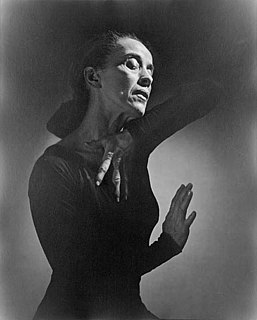
Modern dance is a broad genre of western concert or theatrical dance which included dance styles such as ballet, folk, ethnic, religious, and social dancing; and primarily arose out of Europe and the United States in the late 19th and early 20th centuries. It was considered to have been developed as a rejection of, or rebellion against, classical ballet, and also a way to express social concerns like socioeconomic and cultural factors.

The arts refers to the theory, human application and physical expression of creativity found in human cultures and societies through skills and imagination in order to produce objects, environments and experiences. Major constituents of the arts include visual arts, literary arts, performing arts, and culinary arts.

Authenticity in art is manifest in the different ways that a work of art, or an artistic performance, can be considered authentic. The initial distinction is between nominal authenticity and expressive authenticity. In the first sense, nominal authenticity is the correct identification of the author of a work of art; of how closely an actor or an actress interprets a role in a stageplay as written by the playwright; of how well a musician’s performance of an artistic composition corresponds to the composer’s intention; and how closely an objet d’art conforms to the artistic traditions of its genre. In the second sense, expressive authenticity is how much the work of art possesses inherent authority of and about its subject, and how much of the artist’s intent is in the work of art.
A choreopoem is a form of dramatic expression that combines poetry, dance, music, and song. The term was first coined in 1975 by American writer Ntozake Shange in a description of her work, For Colored Girls Who Have Considered Suicide / When the Rainbow Is Enuf. Shange's attempt to depart from traditional western poetry and storytelling resulted in a new art form that doesn't contain specific plot elements or characters, but instead focuses on creating an emotional response from the audience. In Shange’s work, nontraditional spelling and vernacular are aspects of this genre that differ from traditional American literature. She emphasizes the importance of movement and nonverbal communication throughout the choreopoem so that it is able to function as a theatrical piece rather than being limited to poetry or dance.
References
- ↑ Massachusetts Institute of Technology, Course Description: Dance Theory and Composition, 2003.
- ↑ Milton H. Snoeyenbos and Carole A. Knapp, Dance Theory and Dance Education, Journal of Aesthetic Education, Vol. 13, No. 3 (Jul., 1979), pp. 17-30.
- ↑ Nichelle, Musicality In Dance: What Is It? Can It Be Taught? March 29, 2010
- ↑ Contemporary-Dance.org Dance Theory